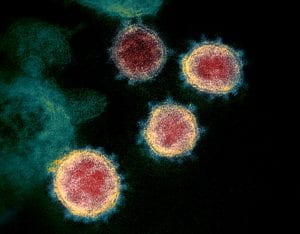Many of us have been vaccinated against COVID-19 and have had the virus, leading us to become used to the virus being prevalent in our lives during the past few years. Even though a successful vaccine has been rolling out for a while now, new therapies have not yet been discovered for future strains. Finding new therapies for the virus remains a major priority in the field of science, even if many of us have been protected already. This issue remains a priority because new variants and strains have been continuing to emerge, and some resist present therapy mechanisms.
SARS-CoV-2
The most effective approach to attempting to combat the virus is addressing the proteins on the surface of therapeutic targets, known as spike proteins. The spike protein (S proteins) located on the surface of the virus leads to its spiky protrusions, and its mechanism to enter human cells. Like we learned in AP Biology class, the spike proteins of the virus latch to cells by matching with a specific receptor on a cell’s surface. The spike proteins of the virus have to latch on to the new cell to infect. Successful messenger RNA vaccines properly target this spike protein, which is the main goal when creating new therapies for viruses.
 Spiky appearance of SARS CoV-2 virus
Spiky appearance of SARS CoV-2 virus
Luigi Gervasio, a chemistry and structural/molecular biology professor at University College London, and his team have been working towards addressing this issue. By partnering with the University of Barcelona’s research team, the two teams took the first steps to discover a possible mechanism for future drugs to detect and protect against the SARS CoV-2 Virus. Through thorough research and investigation, they uncovered a “hidden” cavity on the surface of a prominent infectious agent of the virus known as Nsp1. The team was able to make this discovery by testing small molecules that had the potential to bind to the Nsp1 cavity. The team identified one, 5 acetylaminoindane, which is essential for the development of new drugs against viruses. They concluded that this cavity permitted the calculation of the cavity’s atomically spatial arrangement, which will allow the development of these drugs.
The results of their breakthrough findings set the stage for developing new therapies that will be able to target the NSp1 protein against SARS-CoV-2 and present Nsp1 proteins in future coronavirus strains. Not only will this finding be impactful for targeting SARS-CoV-2 and future variants, but also new cavities on the surface of other proteins that have yet to be found by scientists. Finally, this research is monumental for both SARS-CoV-2 and virus treatment in years to come!



Leave a Reply